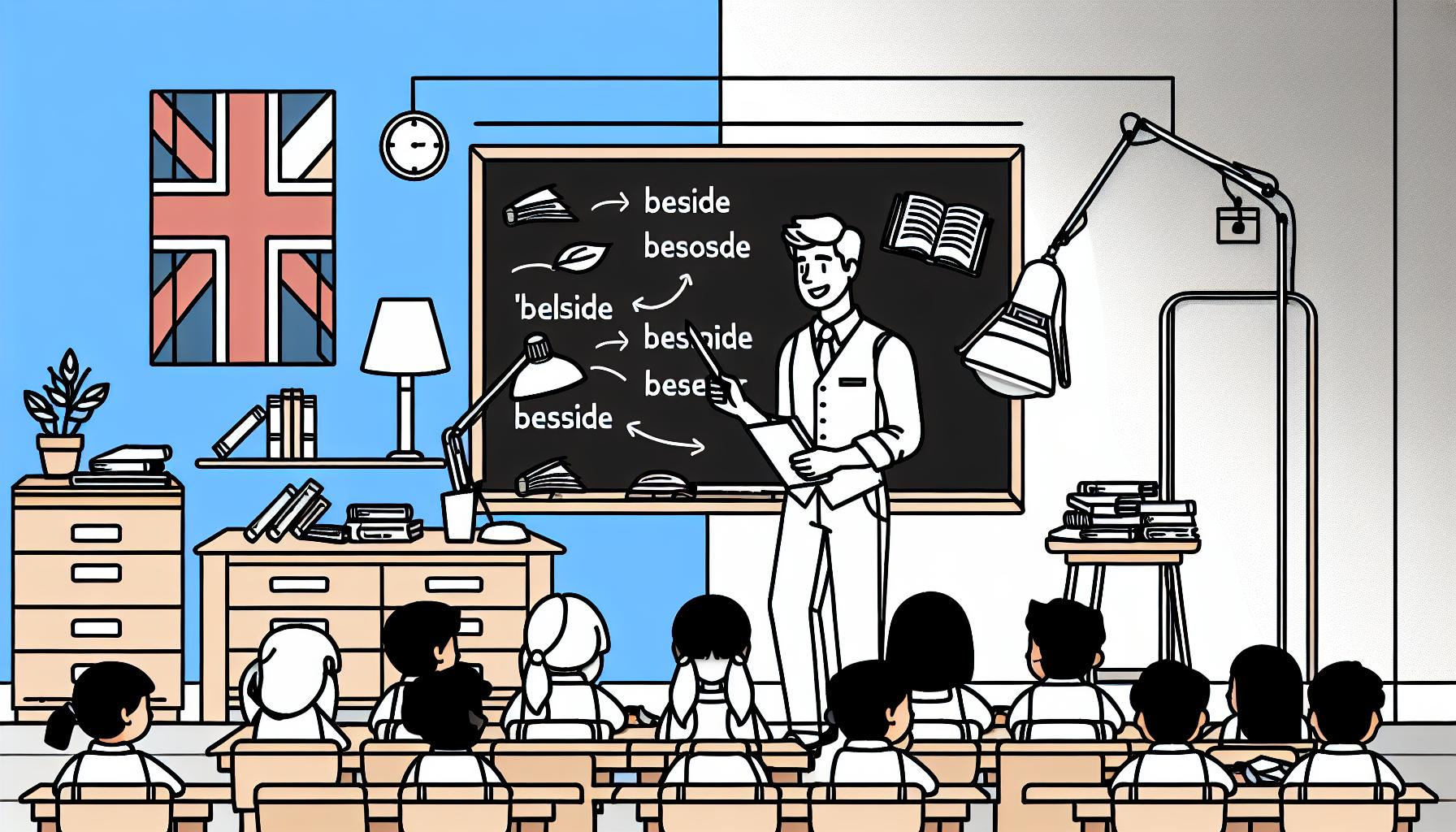When it comes to choosing between “beside” and “besides”, many of us find ourselves scratching our heads. These two words may look similar, but they serve different purposes in our sentences. Understanding the distinction not only improves our writing but also helps us communicate more clearly.
“Beside” typically refers to being next to something, while “besides” often means plus to. By mastering their correct usage, we can enhance our language skills and avoid common pitfalls. So, let’s jump into the nuances of “beside” and “besides” to make our writing more precise and effective.
Key Takeaways
- “Beside” vs “Besides”: “Beside” means next to or at the side of something, whereas “besides” means in addition to or also.
- Usage of “Beside”: Typically denotes physical location (e.g., “My house is beside the park”) or comparison (e.g., “Beside her, everyone looked unprepared”).
- Usage of “Besides”: Functions as an adverb to introduce additional information (e.g., “I’m busy. Besides, it’s raining”) or as a preposition to mean “plus” (e.g., “What other hobbies do you have besides painting?”).
- Common Mistakes: Avoid using “besides” for physical proximity and “beside” for adding information. For example, say “My shop is beside the café,” and “Besides studying, I work part-time.”
- Grammar Rules: “Beside” is always a preposition, while “besides” can be both a preposition and an adverb.
- Professional Application: Correct usage of these terms is crucial for clear communication in business and academic settings, enhancing both written and spoken English.
Understanding “Beside”
Definition and Usage
Beside is a crucial word in English, often used to specify physical location or position, meaning “next to” or “at the side of”. Plus to physical location, it can indicate comparison between two things.
- Physical Location:
- It describes the position of one object relative to another.
- Example: “My phone is beside the TV.”
- Example: “Will you sit beside me at dinner?”
- Comparison:
- It can be used to compare things.
- Example: “Beside some professional-looking Pinterest posts, my craft projects look quite plain.”
- Next to an Object:
- “I place my dream journal beside my bed every night.”
- “The barn beside the farmer’s house was falling down.”
- Support or Accompaniment:
- “When I lost, my best friend sat beside me all night and supported me.”
- Comparison:
- “Beside some professional-looking Pinterest posts, my craft projects look quite plain.”
Using “beside” correctly enhances clarity and precision in language, benefiting those learning English or preparing for exams like IELTS or TOEFL.
Understanding “Besides”

Definition and Usage
“Besides” often causes confusion due to its similarity to “beside,” yet it serves distinct functions in our language. As an adverb, “besides” means “plus” or “also,” adding an extra point or reason. For instance, we might say, “I’m too tired to go for a walk. Besides, it’s raining.” Here, “besides” emphasises an additional reason.
As a preposition, “besides” indicates something extra or additional. For example, “What other sports do you play besides hockey?” It can also mean “other than” or “except,” such as in, “I’ve got no family besides my parents.” Mastering the usage of “besides” is essential to enhance clarity when we learn English, especially in contexts like IELTS or TOEFL exams.
- Adverb:
- “I’m too busy to join the meeting. Besides, I have other commitments.”
- “She didn’t go to the concert. Besides, she doesn’t like loud music.”
- Preposition:
- “Who else can attend the seminar besides you?”
Differences Between “Beside” and “Besides”
Understanding when to use “beside” and “besides” is crucial for anyone aiming to learn English effectively or improve their language skills for exams like IELTS and TOEFL. These two words, although similar, have distinct meanings and usages.
Contextual Applications
“Beside” specifically indicates physical proximity or location.
- Example: “My book is beside the lamp.” Here, “beside” shows the book’s position next to the lamp.
“Besides” can function as both a preposition and an adverb.
- Preposition Example: “No one besides me understood the lecture.” This indicates that apart from me, no one else understood.
- Adverb Example: “She was tired. Besides, it was getting late.” Here, “besides” adds additional information, underlining why she was not willing to continue.
Both terms have distinct applications that should be mastered to enhance communication skills, particularly in Business English and language immersion courses.
Grammar Rules
“Beside” is solely a preposition.
- It does not have an “s” and means “next to” or “at the side of.” For instance, “There’s a bench beside the tree.”
“Besides” is versatile, acting as both a preposition and an adverb.
- As a preposition, it means “plus to” or “apart from.” Example: “What languages do you speak besides English?”
- As an adverb, it translates to “besides” or “also.” Example: “We can’t afford a holiday. Besides, we need to save for the new house.”
Differentiating between these uses can significantly enhance clarity and precision in English writing and speaking, valuable for academic and professional settings.
Common Mistakes
Misusing “beside” and “besides” often leads to confusion in writing and speaking. Understanding their differences improves our language skills, especially when preparing for exams like IELTS or TOEFL.
- Using ‘besides’ for physical proximity:
- Incorrect: “My house is besides the park.”
- Correct: “My house is beside the park.”
- Substituting ‘beside’ for ‘besides’ in additional information:
- Incorrect: “Beside classical music, I like listening to Bollywood music.”
- Correct: “Besides classical music, I like listening to Bollywood music.”
- Interchanging ‘beside’ and ‘besides’ in the same context:
- Incorrect: “The notebook is besides the pen, beside reading, I enjoy playing cricket.”
- Correct: “The notebook is beside the pen. Besides reading, I enjoy playing cricket.”
- Confusing context-specific usage:
- Incorrect: “Besides the fire, we sat and talked.”
- Correct: “Beside the fire, we sat and talked.”
Clarifying these common mistakes in using “beside” and “besides” helps us enhance our writing and speaking skills. Proper usage is particularly important in Business English or Language Immersion contexts. This precision enables us to communicate more effectively, ensuring clarity whether we’re in English courses, preparing for language exams, or engaging in professional settings.
Tips for Correct Usage
When deciding between “beside” and “besides,” it’s crucial to understand their distinct roles in sentences.
1. Physical Proximity:
Use “beside” to describe physical location or position.
- Example: “The museum is beside the park.”
- Focus: “Beside” indicates something is next to something else.
2. Adding Information:
Use “besides” when providing additional information or items.
- Example (preposition): “He enjoys playing chess besides reading.”
- Context: Besides, here means plus to specifying his interests.
3. Emphasising Additional Points:
As an adverb, “besides” adds extra emphasis or reason.
- Example (adverb): “We can’t attend the meeting. Besides, we’re fully booked.”
- Note: Besides, as an adverb, offers an additional reason to the primary statement.
4. Exam Preparation:
Understanding these distinctions is vital for those preparing for exams like IELTS and TOEFL.
- Example: “Apart from grammar, focus on vocabulary besides other skills.”
- Importance: These distinctions enhance clarity, essential for language tests.
5. Business and Further Learning:
In Business English and Language Immersion contexts, proper usage of “beside” and “besides” ensures effective communication.
- Example: “Sit beside the client to discuss the proposal.”
- Example: “Besides the initial investment, consider the long-term benefits.”
- Insight: These examples show practical applications for professional communication.
Mastering these tips not only aids in learning English but also ensures precise and effective language use in various contexts.
Conclusion
Understanding the difference between “beside” and “besides” is crucial for clear and precise communication. By mastering their distinct meanings and uses, we can significantly enhance our writing and speaking skills. Whether we’re preparing for exams or aiming to improve our Business English, grasping these nuances will serve us well.
Let’s remember, “beside” indicates physical proximity, while “besides” adds information. By practising these distinctions, we ensure our language is both effective and accurate. So, let’s continue refining our skills to communicate with confidence and clarity in all contexts.
Frequently Asked Questions
What is the main difference between “beside” and “besides”?
“Beside” means next to something physically, indicating location or position. “Besides” means in addition to or also, used to add extra information or points.
How do I use “beside” in a sentence?
Use “beside” to indicate proximity: “The lamp is beside the bed.” It specifies that something is next to or alongside another object.
Can “beside” be used as anything other than a preposition?
No, “beside” is only used as a preposition to indicate physical proximity, like in “She stood beside her friend.”
How do I use “besides” correctly?
“Besides” can be an adverb or a preposition. As an adverb: “I don’t want to go. Besides, it’s raining.” As a preposition: “She plays the piano besides the guitar.”
Why is it important to understand the difference between “beside” and “besides”?
Understanding the difference enhances clarity and precision in writing and communication, which is particularly important for English learners and those taking exams like IELTS or TOEFL.
Are there common mistakes to avoid when using “beside” and “besides”?
Yes, many confuse the two. For example, incorrect: “Besides the lamp” when meaning physical location. Correct: “Beside the lamp” for physical proximity, “Besides the lamp” for additional items.
Can mastering “beside” and “besides” improve my exam scores?
Yes, using these words correctly can improve clarity and precision in your writing, which is beneficial for exams like IELTS and TOEFL.
What can I do to avoid confusion between “beside” and “besides”?
Practise using each word correctly in sentences. Remember: “beside” is for physical location, “besides” is for adding information.
Are “beside” and “besides” used frequently in Business English?
Yes, especially in writing and speaking contexts where precision and clarity are crucial. Understanding their correct usage can enhance professional communication.



